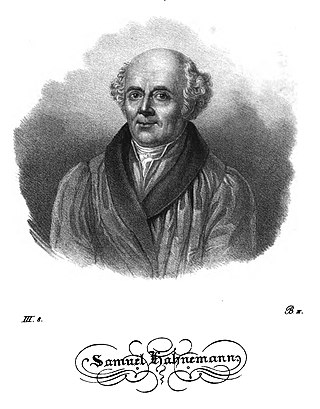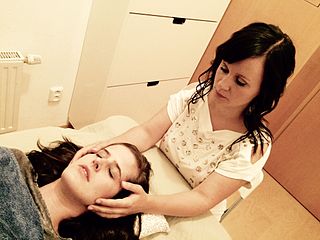Related Research Articles
Alternative medicine is any practice that aims to achieve the healing effects of medicine despite lacking biological plausibility, testability, repeatability or evidence of effectiveness. Unlike modern medicine, which employs the scientific method to test plausible therapies by way of responsible and ethical clinical trials, producing repeatable evidence of either effect or of no effect, alternative therapies reside outside of mainstream medicine and do not originate from using the scientific method, but instead rely on testimonials, anecdotes, religion, tradition, superstition, belief in supernatural "energies", pseudoscience, errors in reasoning, propaganda, fraud, or other unscientific sources. Frequently used terms for relevant practices are New Age medicine, pseudo-medicine, unorthodox medicine, holistic medicine, fringe medicine, and unconventional medicine, with little distinction from quackery.
Evidence-based medicine (EBM) is "the conscientious, explicit and judicious use of current best evidence in making decisions about the care of individual patients. ... [It] means integrating individual clinical expertise with the best available external clinical evidence from systematic research." The aim of EBM is to integrate the experience of the clinician, the values of the patient, and the best available scientific information to guide decision-making about clinical management. The term was originally used to describe an approach to teaching the practice of medicine and improving decisions by individual physicians about individual patients.

Homeopathy or homoeopathy is a pseudoscientific system of alternative medicine. It was conceived in 1796 by the German physician Samuel Hahnemann. Its practitioners, called homeopaths or homeopathic physicians, believe that a substance that causes symptoms of a disease in healthy people can cure similar symptoms in sick people; this doctrine is called similia similibus curentur, or "like cures like". Homeopathic preparations are termed remedies and are made using homeopathic dilution. In this process, the selected substance is repeatedly diluted until the final product is chemically indistinguishable from the diluent. Often not even a single molecule of the original substance can be expected to remain in the product. Between each dilution homeopaths may hit and/or shake the product, claiming this makes the diluent "remember" the original substance after its removal. Practitioners claim that such preparations, upon oral intake, can treat or cure disease.

Bach flower remedies (BFRs) are solutions of brandy and water—the water containing extreme dilutions of flower material developed by Edward Bach, an English homeopath, in the 1930s. Bach claimed that the dew found on flower petals retains the supposed healing properties of that plant. Systematic reviews of clinical trials of Bach flower solutions have found no efficacy beyond that of a placebo.

Craniosacral therapy (CST) or cranial osteopathy is a form of alternative medicine that uses gentle touch to feel non-existent rhythmic movements of the skull's bones and supposedly adjust the immovable joints of the skull to achieve a therapeutic result. CST is a pseudoscience and its practice has been characterized as quackery. It is based on fundamental misconceptions about the anatomy and physiology of the human skull and is promoted as a cure-all for a variety of health conditions.

Traditional Korean medicine refers to the forms of traditional medicine practiced in Korea.
Anthroposophic medicine is a form of alternative medicine based on pseudoscientific and occult notions. Devised in the 1920s by Rudolf Steiner (1861–1925) in conjunction with Ita Wegman (1876–1943), anthroposophical medicine draws on Steiner's spiritual philosophy, which he called anthroposophy. Practitioners employ a variety of treatment techniques based upon anthroposophic precepts, including massage, exercise, counselling, and administration of substances.

Edzard Ernst is a retired British-German academic physician and researcher specializing in the study of complementary and alternative medicine. He was Professor of Complementary Medicine at the University of Exeter, the world's first such academic position in complementary and alternative medicine.
Hoxsey Therapy or Hoxsey Method is an alternative medical treatment promoted as a cure for cancer. The treatment consists of a caustic herbal paste for external cancers or a herbal mixture for "internal" cancers, combined with laxatives, douches, vitamin supplements, and dietary changes. Reviews by major medical bodies, including the U.S. Food and Drug Administration (FDA), the National Cancer Institute, the American Cancer Society, M. D. Anderson Cancer Center, and Memorial Sloan-Kettering Cancer Center, have found no evidence that Hoxsey Therapy is an effective treatment for cancer. The sale or marketing of the Hoxsey Method was banned in the United States by the FDA on September 21, 1960 as a "worthless and discredited" remedy and a form of quackery.

Alternative cancer treatment describes any cancer treatment or practice that is not part of the conventional standard of cancer care. These include special diets and exercises, chemicals, herbs, devices, and manual procedures. Most alternative cancer treatments do not have high-quality evidence supporting their use and many have been described as fundamentally pseudoscientific. Concerns have been raised about the safety of some purported treatments and some have been found unsafe in clinical trials. Despite this, many untested and disproven treatments are used around the world.

Energy medicine is a branch of alternative medicine based on a pseudo-scientific belief that healers can channel "healing energy" into patients and effect positive results. The field is defined by shared beliefs and practices relating to mysticism and esotericism in the wider alternative medicine sphere rather than any sort of unified terminology, leading to terms such as energy healing, vibrational medicine, and similar terms being used synonymously. In most cases, no empirically measurable "energy" is involved: the term refers instead to so-called subtle energy. Practitioners may classify their practice as hands-on, hands-off, or distant wherein the patient and healer are in different locations. Many approaches to energy healing exist: for example, “biofield energy healing”, “spiritual healing”, “contact healing”, “distant healing”, therapeutic touch, Reiki, and Qigong.
Live blood analysis (LBA), live cell analysis, Hemaview or nutritional blood analysis is the use of high-resolution dark field microscopy to observe live blood cells. Live blood analysis is promoted by some alternative medicine practitioners, who assert that it can diagnose a range of diseases. There is no scientific evidence that live blood analysis is reliable or effective, and it has been described as a fraudulent means of convincing people that they are ill and should purchase dietary supplements.
A coffee enema is the injection of coffee into the rectum and colon via the anus, i.e., as an enema. There is no scientific evidence to support any positive health claim for this practice, and medical authorities advise that the procedure may be dangerous. Coffee enemas are an important part of Gerson therapy, a discredited alternative cancer treatment that was promoted by the Gerson Institute in the 1970s.
The Prince's Foundation for Integrated Health (FIH) was a charity run by King Charles III founded in 1993. The foundation promoted complementary and alternative medicine, preferring to use the term "integrated health", and lobbied for its inclusion in the National Health Service. The charity closed in 2010 after allegations of fraud and money laundering led to the arrest of a former official.

Trick or Treatment? Alternative Medicine on Trial is a 2008 book by Simon Singh and Edzard Ernst. The book evaluates the scientific evidence for alternative medicines such as acupuncture, homeopathy, herbal medicine, and chiropractic, and briefly covers 36 other treatments. It finds that the scientific evidence for these alternative treatments is generally lacking. The authors concluded that homeopathy is merely a placebo.

Rudolf Breuss was an Austrian naturopath and alternative cancer treatment advocate. He promoted the Breuss Cancer Cure (BCC) a 42-day juice fasting program.
The Oasis of Hope Hospital is a clinic in Tijuana, Mexico providing alternative cancer treatments to its customers. The clinic was founded by the physician Ernesto Contreras. After his death in 2003, the management of the hospital was taken over by his son, Francisco Contreras, and nephew, Daniel Kennedy.
Alternative medicine describes any practice which aims to achieve the healing effects of medicine, but which lacks biological plausibility and is untested or untestable. Complementary medicine (CM), complementary and alternative medicine (CAM), integrated medicine or integrative medicine (IM), and holistic medicine are among many rebrandings of the same phenomenon.
The infinitesimally low concentration of homeopathic preparations, which often lack even a single molecule of the diluted substance, has been the basis of questions about the effects of the preparations since the 19th century. Modern advocates of homeopathy have proposed a concept of "water memory", according to which water "remembers" the substances mixed in it, and transmits the effect of those substances when consumed. This concept is inconsistent with the current understanding of matter, and water memory has never been demonstrated to exist, in terms of any detectable effect, biological or otherwise.
References
- 1 2 3 4 5 6 "About Cancer". Cancer Research UK. 30 August 2017. Retrieved 8 August 2018.
there isn't any scientific evidence to prove that it is safe or works as a treatment for any type of illness
- 1 2 3 4 Ernst, Edzard (2009). "Carctol: Profit before Patients?". Breast Care. 4 (1): 31–33. doi:10.1159/000193025. PMC 2942009 . PMID 20877681.
- ↑ Marks, N. (2004). "PR coup for herbal cancer drug". BMJ. 329 (7469): 804. doi:10.1136/bmj.329.7469.804. PMC 521016 .
- ↑ Hall, Harriet A. (2012). "CAM for cancer: Preying on desperate people?". Progress in Palliative Care. 20 (5): 295–299. doi:10.1179/1743291X12Y.0000000009. S2CID 72796644.